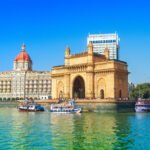Maa Hateshwari Devi Dhroda Dhar Tour, Best Offbeat Temple in DevBhumi Mandi
Introduction to Maa Hateshwari Devi Dhroda Dhar Temple
Nestled in the picturesque landscape of Sundernagar, within the Mandi district of Himachal Pradesh, Maa Hateshwari Devi, Dhroda Dhar Temple stands as a beacon of spiritual serenity and natural beauty. This revered temple is not only a place of worship but also a significant landmark that draws pilgrims and tourists alike. The temple’s location amidst the lush greenery and rolling hills offers a tranquil escape from the hustle and bustle of urban life, making it an ideal destination for those seeking both spiritual solace and scenic beauty.

According to the religious beliefs of the temple, Maa Hateshwari Devi is considered the goddess of power and knowledge. The devotees here wish for happiness, prosperity and success in their life by having darshan of Maa Hateshwari Devi. This place becomes a center of special attraction especially during the time of Navratri, when a large number of devotees gather here.
Daily puja has special significance in the temple and aarti, havan and other religious rituals are performed here every day. Devotees perform various types of worship here to fulfill their wishes. The sanctity of the temple and the religious rituals here provide a unique spiritual experience to the devotees. The temple of Maa Hateshwari Devi is situated amidst the beauty and natural beauty of the mountains, which makes the place even more picturesque. The warm and devotional atmosphere here provides a unique experience to every visitor, leading to spiritual and mental peace.
Maa Hatheshwari Devi Temple is not only important from the religious point of view, but the site is also famous for its environmental and natural beauty. Situated in the hills of Droda Dhar, the lush green forests, peaceful environment and natural views around this temple are unique, which provide peace and tranquility to the minds of the devotees.
History of Temple
Maa Hateshwari Devi Temple was built in ancient times, and this temple is located in Droda Dhar in Mandi district of Himachal Pradesh. This temple is an important pilgrimage site, which is famous for its religious and historical significance. It is believed that this temple was built during the time of the Pandavas. According to legends, when the Pandavas were traveling in the Himalayas during their exile, they established this temple.

Talking about the architecture of the temple, this style presents an excellent example of Himachali architecture. Stone and wood have been beautifully used in the structure of the temple, which makes it extremely attractive. Beautiful carvings and sculptures have been done on the walls of Maa Hateshwari Devi Temple, which further enhances its antiquity and religious significance.
There are many important events and legends associated with the history of the temple. According to a famous legend, when the Pandavas were passing through this area, they installed the idol of Goddess Hateshwari here and built this temple in her honor. Since then, this temple became an important religious place for the devotees. Every year thousands of devotees come here to visit and worship Maa Hateshwari Devi.
The history of the temple is rich and diverse, which includes religious, cultural and social aspects. This temple is not only a religious place, but it is also an important part of the cultural heritage of Himachal Pradesh. The history of Maa Hateshwari Devi Temple gives us a glimpse of the religious beliefs and excellent traditions of architecture of this region.
The structure of the temple reflects the traditional Kathkuni style, in which the walls are built with a combination of square wooden pillars and stones. This style has a mixture of wood and stone, which not only enhances the beauty but also makes it earthquake resistant. The main entrance of the temple has beautiful carvings, which depict scenes from gods and goddesses and mythology.
In the interior decoration, the paintings and sculptures done on the walls of the main sanctum are very attractive. The idol of Goddess Hateshwari is specially decorated, around which the glow of lamps gives it divinity. The paintings and carvings done on the inner walls of the sanctum are excellent examples of medieval Indian art.
The exterior of the temple also has intricate carvings and decorations. The roof structure is also very unique, which is a combination of wooden planks and stones. Various sculptures and architectural elements in the verandah and courtyard make it important from a religious and cultural point of view.
Religious Significance of Maa Hateshwari Devi Temple
Maa Hateshwari Devi, Dhroda Dhar Temple stands as a beacon of deep spiritual significance in Sundernagar, Mandi, Himachal Pradesh. This revered place of worship is dedicated primarily to Lord Shiva, one of the principal deities in Hinduism. Devotees flock here to pay homage to Shiva, who is venerated for his transcendent powers, mastery over worldly desires, and as the ultimate destroyer of evil. The temple’s ambiance engulfs visitors with a sense of tranquility and divine presence, making it a prized destination for spiritual seekers.

In addition to Lord Shiva, the temple also houses idols of other significant deities, including Goddess Parvati, Lord Ganesha, and Lord Kartikeya. Each of these divine figures has their own space within the temple, allowing devotees to offer prayers and seek blessings. Rituals conducted here are an integral part of the spiritual fabric of Droda Dhar Temple. Daily aarti (devotional rituals involving light), recitations of sacred hymns from the Vedas, and abhishekam (ceremonial bathing of deities) are observed with great devotion and reverence.
The temple is also a vibrant hub for various festivals, which are celebrated with much fervor and zeal. Maha Shivaratri, dedicated to Lord Shiva, marks the pinnacle of the temple’s religious calendar. Devotees engage in an all-night vigil and perform special pujas (worship rituals). Other significant festivals include Navratri dedicated to Goddess Durga, Ganesh Chaturthi for Lord Ganesha, and Kartik Purnima commemorating Lord Kartikeya. These festivals not only enhance the devotional fervor but also serve to bring together people from different walks of life in communal harmony.
Many devotees recount profound spiritual experiences during their visits to Droda Dhar Temple. The serene natural surroundings and the palpable sense of divinity often induce feelings of peace and enlightenment. Some visitors have reported miraculous events and visions, attributing them to the powerful spiritual energy that permeates the temple grounds. Whether it is through prayer, meditation, or simply being in the presence of the sacred, Droda Dhar Temple continues to be a sanctuary for those seeking spiritual solace and enlightenment.
The Scenic Beauty around Maa Hateshwari Devi Temple
Nestled in the picturesque hills of Dhroda Dhar in Sundernagar, Mandi, Himachal Pradesh, the Maa Hateshwari Devi Temple offers more than just spiritual solace. The temple is surrounded by an awe-inspiring natural landscape that profoundly enhances the visitor experience. As you ascend towards the temple, you’re greeted by a lush, green sanctuary enriched with diverse flora and fauna, revealing the pristine beauty of the Himalayas.
Adding to the temple’s charm is its panoramic vantage point. From here, visitors can enjoy sweeping views of the surrounding valleys and hills. The clear, blue skies and the mist-covered peaks in the distance create a mesmerizing backdrop that invites visitors to pause and absorb the natural beauty. The serene Beas River meanders through the valleys below, its pristine waters reflecting the sunlight and enhancing the scenic vista.
The tranquil atmosphere surrounding Maa Hateshwari Devi Temple significantly augments the spiritual experience for visitors. The combination of majestic natural landscapes, soothing sounds of nature, and the serene environment make it a perfect retreat for those seeking peace and introspection. Whether you’re on a spiritual pilgrimage or simply a nature lover, the journey to Maa Hateshwari Devi Temple is profoundly enriching.
Fauna in the region is equally captivating. The forests provide a habitat for various species of Himalayan birds, butterflies, and occasionally, glimpses of small mammals. This rich biodiversity not only adds to the spiritual allure of the location but also offers nature enthusiasts an opportunity to connect with the environment.
How to reach Maa Hateshwari Devi Temple
By Air,
The nearest airport is Bhuntar Airport, located approximately 70 kilometers from the temple. Bhuntar Airport offers regular flights from major cities like Delhi, making it an accessible gateway for travelers. From Bhuntar, a scenic drive via NH3 and NH154 will lead you directly to the temple.
By Train,
The closest railway station is Joginder Nagar, which is about 60 kilometers away. Joginder Nagar is connected to several key cities, ensuring a convenient rail journey. From the station, taxis and buses are readily available to ferry visitors to the temple grounds.
By Road,
The temple can be reached via a well-maintained network of national and state highways. If traveling from Chandigarh, a popular entry point, the journey via NH205 is both efficient and aesthetically pleasing, covering a distance of approximately 146 kilometers. The route meanders through lush landscapes, offering travelers a visual treat as they approach the serene environs of Dhroda Dhar.
By Bus,
Local buses operated by the Himachal Pradesh Transport Corporation (HPTC) are also a reliable and cost-effective means to reach the temple. Buses ply regularly from key towns such as Mandi and Sundernagar, ensuring that visitors have frequent and dependable access to the destination.
Visitors Tips and Guidelines
Best Times to Visit:
The temple can be visited year-round, but the most favorable times are during the festivals of Navratri, which attract a significant number of devotees. The months between March and October offer pleasant weather, making it comfortable for visitors, whereas winters can be quite cold.
What to Wear:
Boasting a serene and sacred ambiance, Maa Hateshwari Devi Temple requires visitors to dress modestly. Traditional Indian attire or comfortable yet respectful clothing is recommended. Footwear must be removed before entering the temple premises, so it is advisable to wear shoes that are easy to take off.
Local Customs and Etiquette:
Respect towards the local customs is paramount when visiting any place of worship. Devotees often follow rituals such as taking a bath before entering the temple and offering prasad (sacred food). It is important to maintain silence or speak softly to preserve the sanctity of the temple environment. Photography inside the temple premises is generally discouraged, so check for any specific instructions.
Accommodation Options:
Sundernagar and Mandi offer various accommodation options ranging from budget hotels to luxury resorts. Staying in Sundernagar places you in proximity to the temple, making your commute easier. Some devotees might also opt for guesthouses operated by temple trusts, which provide convenient and cost-effective lodging.
Necessary Precautions:
Given the temple’s location, carrying some essentials is advisable. Bottled water, light snacks, and essential medications should be packed, along with a basic first-aid kit. It is also prudent to check the weather forecast and dress accordingly. Mobile connectivity might be sporadic in certain areas, so informing someone about your travel plan is wise.
Nearby Attractions
Visitors to Maa Hateshwari Temple in Dhrida Dhar, Sundernagar, Mandi, Himachal Pradesh, will find themselves immersed in a region enriched with other notable attractions and points of interest. Nestled in the serene landscapes of Himachal Pradesh, the temple is a starting point for various explorations.
- The Rewalsar Lake offers a tranquil getaway. Enveloped by vibrant forests and towering mountains, this sacred lake is revered in Hinduism, Buddhism, and Sikhism. The lake’s distinct charm comes from its floating reed islands and panoramic scenery, making it an ideal spot for spiritual reflection and leisurely walks along its periphery.
- The Sunder Nagar Lake, renowned for its stunning vistas and peaceful ambiance. Surrounded by lush gardens, the lake is perfect for a relaxed afternoon picnic or a picturesque boat ride. The sunset views here are spectacular, often drawing photographers and nature enthusiasts.
- The Bhimakali Temple in Sarahan is a must-visit. Adorned with intricate wood carvings, this temple is not only an architectural marvel but also a spiritual hub. Pilgrims seeking blessings often follow a trail of smaller temples along the way, making it a meaningful journey.
- The Great Himalayan National Park, located within a reasonable distance. This UNESCO World Heritage site boasts rich biodiversity, including rare plant and animal species. Trekking, bird watching, and wildlife photography are popular activities here, offering a deeper connection to the region’s natural beauty.
- The Pandoh Dam, which provides insights into the region’s hydroelectric power infrastructure while offering beautiful river views. Additionally, Mandi town itself, known as Choti Kashi (Little Varanasi), boasts a number of ancient temples worth exploring, like the Triloknath Temple and Panchvaktra Temple.
In Sundernagar, which means “beautiful town,” visitors can also explore charming local markets brimming with handicrafts and traditional Himachali wares. The town offers a glimpse into the local culture and lifestyle, enhancing any trip to the Maa Hateshwari Temple and its surroundings with varied and fulfilling experiences.
What is best time to visit Dhroda Dhar Temple?
The temple can be visited year-round, but the most favorable times are during the festivals of Navratri, which attract a significant number of devotees. The months between March and October offer pleasant weather, making it comfortable for visitors, whereas winters can be quite cold.
How to reach Dhroda Dhar Temple?
Sundernagar is easily accessible by road from major cities in Himachal Pradesh and neighboring states.
You can hire a taxi or bus from Sundernagar to reach the temple. The distance from Sundernagar to the temple is approximately 1 km.
What are local customs and etiquettes in Dhroda Dhar Temple?
Devotees often follow rituals such as taking a bath before entering the temple and offering prasad (sacred food). It is important to maintain silence or speak softly to preserve the sanctity of the temple environment. Photography inside the temple premises is generally discouraged, so check for any specific instructions.
What is the local rituals significance in Dhroda Dhar Temple?
Daily puja has special significance in the temple and aarti, havan and other religious rituals are performed here every day. Devotees perform various types of worship here to fulfill their wishes. The sanctity of the temple and the religious rituals here provide a unique spiritual experience to the devotees. The temple of Maa Hateshwari Devi is situated amidst the beauty and natural beauty of the mountains, which makes the place even more picturesque. The warm and devotional atmosphere here provides a unique experience to every visitor, leading to spiritual and mental peace.
Who is idol in Dhroda Dhar Temple?
Maa Hateshwari Devi is the main idol of the temple. Maa Hateshwari Devi, Dhroda Dhar Temple stands as a beacon of spiritual serenity and natural beauty. This revered temple is not only a place of worship but also a significant landmark that draws pilgrims and tourists alike.
What are necessary precautions for Dhroda Dhar Temple?
Given the temple’s location, carrying some essentials is advisable. Bottled water, light snacks, and essential medications should be packed, along with a basic first-aid kit. It is also prudent to check the weather forecast and dress accordingly. Mobile connectivity might be sporadic in certain areas, so informing someone about your travel plan is wise.















